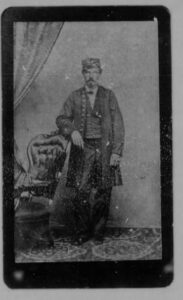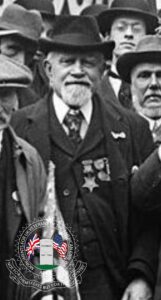Capture the Flag: Corporal George W. Reed
During the U.S. Civil War, many Medals of Honor were awarded for capturing the enemy's flag. George W. Reed was the recipient of one such award on September 6, 1864,…

By Gina Denham, Co-Founder, Monuments for UK Veterans of the American Civil War Association
Medal of Honor recipient, acting ensign Maurice Wagg, was a U.S. Navy veteran. He lived in England and joined the London Branch of American Civil War Veterans at its inauguration on September 20th, 1910, in Bermondsey, south London.
Until recently there has only been one known photograph of Maurice; a faded image contained within his pension file of a young man wearing a navy uniform. In a curious twist of fate, the image of an aging London Branch veteran wearing a Medal of Honor stood among other Civil War peers, became a crucial piece of evidence. The evidence that led to unearthing the identity of Maurice Wagg as an old man, standing proudly in numerous photographs among other Civil War comrades, wearing his Medal.

Born in July 1840, in Christchurch, England, Maurice served from 1861 through to 1868. He enlisted at the naval rendezvous in New York, spent time on the receiving ship North Carolina, then the USS Rhode Island. According to his Medal of Honor citation, he, “Engaged in saving the lives of the officers and crew of the Monitor off Hatteras, 31 December 1862. Participating in the hazardous task of rescuing the officers and crew of the sinking Monitor, Wagg distinguished himself by meritorious conduct during this operation.” In 1865, he claimed he was wounded in the right shoulder by a gunshot at the battle of Fort Fisher.
Maurice eventually returned London, England, and secured his pension in 1903. However, despite being a Medal of Honor recipient, the accolade did not put food on the table. Unable to work, he wrote to the U.S. Pension Bureau, “My right arm is useless, and cannot do any labour…I hope you will be very lenient with me. So that I shall not have to go to the workhouse. If you could only allow me $6 a month, I could get along with that until the dept. [sic] is paid. Dear sir, I went to the consuls general office yesterday, and the vice consul told me not to send my next quarter pension voucher until I get further instructions from you. Dear sir, I am sorry to say that I have not got the money to refund to you. If I had to, I would send it by return of post…”
In September 1913, Maurice numbered among fifty aging veterans present at the West End Theatre in London. The men had been invited to watch the silent war film “The Battle of Gettysburg”. Maurice immediately attracted press attention, not due to his characteristic smart suit and hat, but because he stood resplendent, proudly wearing his Medal of Honor: “Among the guests was Mr Maurice Wagg wearing the American Star…,” reported The East Kent Gazette.
Four years later the American Expeditionary Forces, under the command of General John J. Pershing, arrived in Europe. “Doughboys” from the United States poured into London. The New-York Tribune reported the old London Branch members greeting young American soldiers. They “attracted much attention, as a part of the procession of four thousand American Soldiers marching through the metropolis.” The London Branch added, “A real American touch” according to New York Tribune correspondent Arthur S Draper, who noticed Maurice was present among the veterans, wearing his Medal of Honor. Draper wrote that Wagg was “delighted at the opportunity to participate in an American parade once more.”

Nine years after adding a ‘real American touch,’ Maurice died at his home in Galbraith Street in Poplar on June 22nd 1926. He was interred in an unmarked grave in Newham, East London. Eighty-nine years later an official headstone was obtained, an outcome of the investigative work of author Michael Hammerson. Whilst a monument was raised, Maurice’s identity in old age remained a mystery for another 8 years, until Gina Denham, co-founder of Monuments for UK Veterans of the American added a final piece of the jigsaw to the puzzle.
Gina is not a stranger to spending countless hours following investigative leads to prove or disprove facts. She did that as a former investigator. She also adopted the approach several times to identify previously unknown American Civil war veterans. Whilst undertaking research for her book, “The Landsman and the Lieutenant” she came across several old newspaper articles. They mentioned Maurice had attended events in London with his veteran comrades. She noticed the face of one well-dressed “smiling” veteran who was often present in group photographs. One photograph was of particularly good resolution.
She realized the medal worn by the veteran was noticeably different to others worn by men standing with him. It was not a Grand Army of the Republic medal. She began to join all the dots together, scrutinizing all available photographs of London Branch veterans at events. Particularly any events where press reports suggested Maurice had been present.
Trawling through available photographs was a time-consuming process. However, the time and effort proved worthwhile. It led to the conclusion the medal worn by the ‘smiling veteran’ was a Naval version of the Medal of Honor. He had to be Maurice Wagg, because he was the only Medal of Honor recipient in the London Branch. The Medal of Honor visible in the photograph was a significant and incredible discovery, and establishing his identity in old age could be added to the knowledge-pool.
Identifying Maurice Wagg is an outcome we are very proud of. We feel it highlights the value of Monuments for UK Veterans of the American Civil War Association. because we will follow all opportunities to raise awareness of UK Veterans of the Civil War who have almost been lost from memory.
Gina Denham is the Co-founder of Monuments for UK Veterans of the American Civil War Association. The Association was formed in January 2022 by Gina, and Darren Rawlings. Gina is the great-great-granddaughter of George Denham who served in the 111th PA Volunteers and also as a 2nd Class fireman on the USS Chickasaw. Darren is a researcher and Civil War Living historian. The Association aims to raise awareness of UK veterans of the Civil War. Fifty thousand men and women from the UK served in the Conflict. Like George Denham, about 1 percent are estimated to have returned to the U.K. after the conflict. Find the Association on Facebook https://www.facebook.com/TheMonumentalProject/
